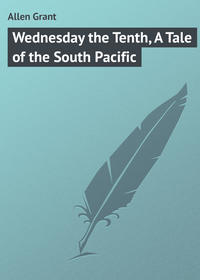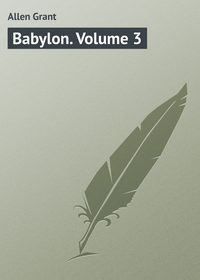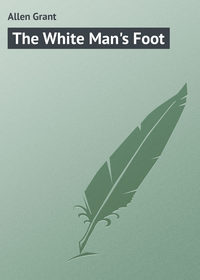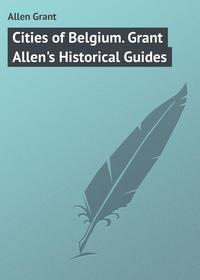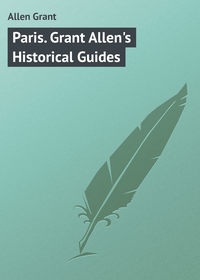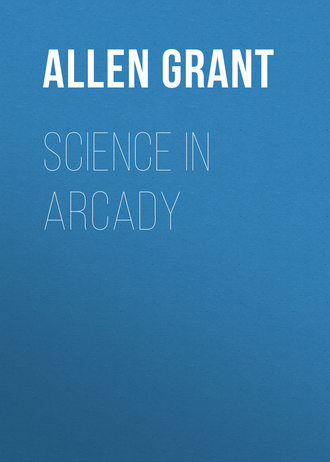 полная версия
полная версияScience in Arcady

Grant Allen
Science in Arcady
PREFACE
These essays deal for the most part with Science in Arcady. 'Tis my native country: for I am not of those who 'praise the busy town.' On the contrary, in the words of the great poet who has just departed to join Milton and Shelley in a place of high collateral glory, I 'love to rail against it still,' with a naturalist's bitterness. For the town is always dead and lifeless. There are who admire it, they say—poor purblind creatures—because, forsooth, 'there is so much life there.' So much life, indeed! No grass in the streets; no flowers in the lanes; no beetles or butterflies on the dull stone pavements! Brick and mortar have killed out all life over square miles of Middlesex. For myself, I love better the densely-peopled fields than this human desert, this beflagged and macadamised man-made solitude. The country teems with life on every hand; a thousand different plants and flowers in the spangled meadows; a thousand varied denizens of pond, and air, and heath, and copses. Their ways are endless. They attract me far more with their infinite diversity than the grey and gloomy haunts of the cab-horse and the stock-broker.
But my Arcady, as you will see, is none the less tolerably broad and eclectic in its limits. These various essays have been suggested to my pen by rambles far and wide between its elastic confines. The little tractate on Mud, for example, recalls to mind some pleasant weeks among the Italian lakes and on the plain of Lombardy. A Desert Fruit owes its origin to a morning at Luxor. High Life had its key-note struck by a fortnight in the Tyrol. Tropical Education is a dim reminiscence of old Jamaican experiences. Our Eight-Legged Friends were observed at leisure on the window-panes of our own little nook at Dorking. A Hill-Top Stronghold was sketched in situ at Florence by a window that looked across the valley to Fiesole. Excursions into books or into the remoter past have given occasion for the archæological essays relegated here to the end of the volume.
My thanks are due to Messrs. Longmans for permission to reprint from their magazine My Islands, A Hill-Top Stronghold, A Desert Fruit, The Isle of Ruim, Eight-Legged Friends, and Tropical Education. I have also to acknowledge a similar courtesy on the part of Messrs. Smith & Elder with regard to Mud, The Bronze Axe, High Life, Pretty Poll, The Greenwood Tree, On the Wings of the Wind, Casters and Chesters, and Fish as Fathers, all of which originally appeared in the Cornhill. Messrs. Chatto & Windus have been equally kind as regards the paper on An English Shire contributed to the Gentleman's. A Persistent Nationality made its first bow in the North American Review, and has still to be introduced to an English audience.
G.A.Hind Head, Surrey,
Oct., 1892.
MY ISLANDS
About the middle of the Miocene period, as well as I can now remember (for I made no note of the precise date at the moment), my islands first appeared above the stormy sheet of the North-West Atlantic as a little rising group of mountain tops, capping a broad boss of submarine volcanoes. My attention was originally called to the new archipelago by a brother investigator of my own aerial race, who pointed out to me on the wing that at a spot some 900 miles to the west of the Portuguese coast, just opposite the place where your mushroom city of Lisbon now stands, the water of the ocean, as seen in a bird's-eye view from some three thousand feet above, formed a distinct greenish patch such as always betokens shoals or rising ground at the bottom. Flying out at once to the point he indicated, and poising myself above it on my broad pinions at a giddy altitude, I saw at a glance that my friend was quite right. Land making was in progress. A volcanic upheaval was taking place on the bed of the sea. A new island group was being forced right up by lateral pressure or internal energies from a depth of at least two thousand fathoms.
I had always had a great liking for the study of material plants and animals, and I was so much interested in the occurrence of this novel phenomenon—the growth and development of an oceanic island before my very eyes—that I determined to devote the next few thousand centuries or so of my æonian existence to watching the course of its gradual evolution.
If I trusted to unaided memory, however, for my dates and facts, I might perhaps at this distance of time be uncertain whether the moment was really what I have roughly given, within a geological age or two, the period of the Mid-Miocene. But existing remains on one of the islands constituting my group (now called in your new-fangled terminology Santa Maria) help me to fix with comparative certainty the precise epoch of their original upheaval. For these remains, still in evidence on the spot, consist of a few small marine deposits of Upper Miocene age; and I recollect distinctly that after the main group had been for some time raised above the surface of the ocean, and after sand and streams had formed a small sedimentary deposit containing Upper Miocene fossils beneath the shoal water surrounding the main group, a slight change of level occurred, during which this minor island was pushed up with the Miocene deposits on its shoulders, as a sort of natural memorandum to assist my random scientific recollections. With that solitary exception, however, the entire group remains essentially volcanic in its composition, exactly as it was when I first saw its youthful craters and its red-hot ash-cones pushed gradually up, century after century, from the deep blue waters of the Mid-Miocene ocean.
All round my islands the Atlantic then, as now, had a depth, as I said before, of two thousand fathoms; indeed, in some parts between the group and Portugal the plummet of your human navigators finds no bottom, I have often heard them say, till it reaches 2,500; and out of this profound sea-bed the volcanic energies pushed up my islands as a small submarine mountain range, whose topmost summits alone stood out bit by bit above the level of the surrounding sea. One of them, the most abrupt and cone-like, by name now Pico, rises to this day, a magnificent sight, sheer seven thousand feet into the sky from the placid sheet that girds it round on every side. You creatures of to-day, approaching it in one of your clumsy new-fashioned fire-driven canoes that you call steamers, must admire immensely its conical peak, as it stands out silhouetted against the glowing horizon in the deep red glare of a sub-tropical Atlantic sunset.
But when I, from my solitary aerial perch, saw my islands rise bare and massive first from the water's edge, the earliest idea that occurred to me as an investigator of nature was simply this: how will they ever get clad with soil and herbage and living creatures? So naked and barren were their black crags and rocks of volcanic slag, that I could hardly conceive how they could ever come to resemble the other smiling oceanic islands which I looked down upon in my flight from day to day over so many wide and scattered oceans. I set myself to watch, accordingly, whence they would derive the first seeds of life, and what changes would take place under dint of time upon their desolate surface.
For a long epoch, while the mountains were still rising in their active volcanic state, I saw but little evidence of a marked sort of the growth of living creatures upon their loose piles of pumice. Gradually, however, I observed that spores of lichens, blown towards them by the wind, were beginning to sprout upon the more settled rocks, and to discolour the surface in places with grey and yellow patches. Bit by bit, as rain fell upon the new-born hills, it brought down from their weathered summits sand and mud, which the torrents ground small and deposited in little hollows in the valleys; and at last something like earth was found at certain spots, on which seeds, if there had been any, might doubtless have rooted and flourished exceedingly.
My primitive idea, as I watched my islands in this their almost lifeless condition, was that the Gulf Stream and the trade winds from America would bring the earliest higher plants and animals to our shores. But in this I soon found I was quite mistaken. The distance to be traversed was so great, and the current so slow, that the few seeds or germs of American species cast up upon the shore from time to time were mostly far too old and water-logged to show signs of life in such ungenial conditions. It was from the nearer coasts of Europe, on the contrary, that our earliest colonists seemed to come. Though the prevalent winds set from the west, more violent storms reached us occasionally from the eastward direction; and these, blowing from Europe, which lay so much closer to our group, were far more likely to bring with them by waves or wind some waifs and strays of the European fauna and flora.
I well remember the first of these great storms that produced any distinct impression on my islands. The plants that followed in its wake were a few small ferns, whose light spores were more readily carried on the breeze than any regular seeds of flowering plants. For a month or two nothing very marked occurred in the way of change, but slowly the spores rooted, and soon produced a small crop of ferns, which, finding the ground unoccupied, spread when once fairly started with extraordinary rapidity, till they covered all the suitable positions throughout the islands.
For the most part, however, additions to the flora, and still more to the fauna, were very gradually made; so much so that most of the species now found in the group did not arrive there till after the end of the Glacial epoch, and belong essentially to the modern European assemblage of plants and animals. This was partly because the islands themselves were surrounded by pack-ice during that chilly period, which interrupted for a time the course of my experiment. It was interesting, too, after the ice cleared away, to note what kinds could manage by stray accidents to cross the ocean with a fair chance of sprouting or hatching out on the new soil, and which were totally unable by original constitution to survive the ordeal of immersion in the sea. For instance, I looked anxiously at first for the arrival of some casual acorn or some floating filbert, which might stock my islands with waving greenery of oaks and hazel bushes. But I gradually discovered, in the course of a few centuries, that these heavy nuts never floated securely so far as the outskirts of my little archipelago; and that consequently no chestnuts, apple trees, beeches, alders, larches, or pines ever came to diversify my island valleys. The seeds that did really reach us from time to time belonged rather to one or other of four special classes. Either they were very small and light, like the spores of ferns, fungi, and club-mosses; or they were winged and feathery, like dandelion and thistle-down; or they were the stones of fruits that are eaten by birds, like rose-hips and hawthorn; or they were chaffy grains, enclosed in papery scales, like grasses and sedges, of a kind well adapted to be readily borne on the surface of the water. In all these ways new plants did really get wafted by slow degrees to the islands; and if they were of kinds adapted to the climate they grew and flourished, living down the first growth of ferns and flowerless herbs in the rich valleys.
The time which it took to people my archipelago with these various plants was, of course, when judged by your human standards, immensely long, as often the group received only a single new addition in the lapse of two or three centuries. But I noticed one very curious result of this haphazard and lengthy mode of stocking the country: some of the plants which arrived the earliest, having the coast all clear to themselves, free from the fierce competition to which they had always been exposed on the mainland of Europe, began to sport a great deal in various directions, and being acted upon here by new conditions, soon assumed under stress of natural selection totally distinct specific forms. (You see, I have quite mastered your best modern scientific vocabulary.) For instance, there were at first no insects of any sort on the islands; and so those plants which in Europe depended for their fertilisation upon bees or butterflies had here either to adapt themselves somehow to the wind as a carrier of their pollen or else to die out for want of crossing. Again, the number of enemies being reduced to a minimum, these early plants tended to lose various defences or protections they had acquired on the mainland against slugs or ants, and so to become different in a corresponding degree from their European ancestors. The consequence was that by the time you men first discovered the archipelago no fewer than forty kinds of plants had so far diverged from the parent forms in Europe or elsewhere that your savants considered them at once as distinct species, and set them down at first as indigenous creations. It amused me immensely.
For out of these forty plants thirty-four were to my certain knowledge of European origin. I had seen their seeds brought over by the wind or waves, and I had watched them gradually altering under stress of the new conditions into fresh varieties, which in process of time became distinct species. Two of the oldest were flowers of the dandelion and daisy group, provided with feathery seeds which enable them to fly far before the carrying breeze; and these two underwent such profound modifications in their insular home that the systematic botanists who at last examined them insisted upon putting each into a new genus, all by itself, invented for the special purpose of their reception. One almost equally ancient inhabitant, a sort of harebell, also became in process of time extremely unlike any other harebell I had ever seen in any part of my airy wanderings. But the remaining thirty new species or so evolved in the islands by the special circumstances of the group had varied so comparatively little from their primitive European ancestors, that they hardly deserved to be called anything more than very distinct and divergent varieties.
Some five or six plants, however, I noted arrive in my archipelago, not from Europe, but from the Canaries or Madeira, whose distant blue peaks lay dim on the horizon far to the south-west of us, as I poised in mid-air high above the topmost pinnacle of my wild craggy Pico. These kinds, belonging to a much warmer region, soon, as I noticed, underwent considerable modification in our cooler climate, and were all of them adjudged distinct species by the learned gentlemen who finally reported upon my island realm to British science.
As far as I can recollect, then, the total number of flowering plants I noted in the islands before the arrival of man was about 200; and of these, as I said before, only forty had so far altered in type as to be considered at present peculiar to the archipelago. The remainder were either comparatively recent arrivals or else had found the conditions of their new home so like those of the old one from which they migrated, that comparatively little change took place in their forms or habits. Of course, just in proportion as the islands got stocked I noticed that the changes were less and less marked; for each new plant, insect, or bird that established itself successfully tended to make the balance of nature more similar to the one that obtained in the mainland opposite, and so decreased the chances of novelty of variation.
Hence, it struck me that the oldest arrivals were the ones which altered most in adaptation to the circumstances, while the newest, finding themselves in comparatively familiar surroundings, had less occasion to be selected for strange and curious freaks or sports of form or colour.
The peopling of the islands with birds and animals, however, was to me even a more interesting and engrossing study in natural evolution than its peopling by plants, shrubs, and trees. I may as well begin, therefore, by telling you at once that no furry or hairy quadruped of any sort—no mammal, as I understand your men of science call them—was ever stranded alive upon the shores of my islands. For twenty or thirty centuries indeed, I waited patiently, examining every piece of driftwood cast up upon our beaches, in the faint hope that perhaps some tiny mouse or shrew or water-vole might lurk half drowned in some cranny or crevice of the bark or trunk. But it was all in vain. I ought to have known beforehand that terrestrial animals of the higher types never by any chance reach an oceanic island in any part of this planet. The only three specimens of mammals I ever saw tossed up on the beach were two drowned mice and an unhappy squirrel, all as dead as doornails, and horribly mauled by the sea and the breakers. Nor did we ever get a snake, a lizard, a frog, or a fresh-water fish, whose eggs I at first fondly supposed might occasionally be transported to us on bits of floating trees or matted turf, torn by floods from those prehistoric Lusitanian or African forests. No such luck was ours. Not a single terrestrial vertebrate of any sort appeared upon our shores before the advent of man with his domestic animals, who played havoc at once with my interesting experiment.
It was quite otherwise with the unobtrusive small deer of life—the snails, and beetles, and flies, and earthworms—and especially with the winged things: birds, bats, and butterflies. In the very earliest days of my islands' existence, indeed, a few stray feathered fowls of the air were driven ashore here by violent storms, at a time when vegetation had not yet begun to clothe the naked pumice and volcanic rock; but these, of course, perished for want of food, as did also a few later arrivals, who came under stress of weather at the period when only ferns, lichens, and mosses had as yet obtained a foothold on the young archipelago. Sea-birds, of course, soon found out our rocks; but as they live off fish only, they contributed little more than rich beds of guano to the permanent colonising of the islands. As well as I can remember, the land-snails were the earliest truly terrestrial casuals that managed to pick up a stray livelihood in these first colonial days of the archipelago. They came oftenest in the egg, sometimes clinging to water-logged leaves cast up by storms, sometimes hidden in the bark of floating driftwood, and sometimes swimming free on the open ocean. In one case, as I recall to myself well, a swallow, driven off from the Portuguese coast, a little before the Glacial period had begun to whiten the distant mountains of central and northern Europe, fell exhausted at last upon the shore of Terceira. There were no insects then for the poor bird to feed upon, so it died of starvation and weariness before the day was out; but a little earth that clung in a pellet to one of its feet contained the egg of a land-shell, while the prickly seed of a common Spanish plant was entangled among the winged feathers by its hooked awns. The egg hatched out, and became the parent of a large brood of minute snails, which, outliving the cold spell of the Ice Age, had developed into a very distinct type in the long period that intervened before the advent of man in the islands; while the seed sprang up on the natural manure heap afforded by the swallow's decaying body, and clinging to the valleys during the Glacial Age on the hill-tops, gave birth in due season to one of the most markedly indigenous of our Terceira plants.
Occasionally, too, very minute land-snails would arrive alive on the island after their long sea-voyage on bits of broken forest-trees—a circumstance which I would perhaps hesitate to mention in mere human society were it not that I have been credibly informed your own great naturalist, Darwin, tried the experiment himself with one of the biggest European land-molluscs, the great edible Roman snail, and found that it still lived on in vigorous style after immersion in sea-water for twenty days. Now, I myself observed that several of these bits of broken trees, torn down by floods in heavy storm time from the banks of Spanish or Portuguese rivers, reached my island in eight or ten days after leaving the mainland, and sometimes contained eggs of small land-snails. But as very long periods often passed without a single new species being introduced into the group, any kind that once managed to establish itself on any of the islands usually remained for ages undisturbed by new arrivals, and so had plenty of opportunity to adapt itself perfectly by natural selection to the new conditions. The consequence was, that out of some seventy land-snails now known in the islands, thirty-two had assumed distinct specific features before the advent of man, while thirty-seven (many of which, I think, I never noticed till the introduction of cultivated plants) are common to my group with Europe or with the other Atlantic islands. Most of these, I believe, came in with man and his disconcerting agriculture.
As to the pond and river snails, so far as I could observe, they mostly reached us later, being conveyed in the egg on the feet of stray waders or water-birds, which gradually peopled the island after the Glacial epoch.
Birds and all other flying creatures are now very abundant in all the islands; but I could tell you some curious and interesting facts, too, as to the mode of their arrival and the vicissitudes of their settlement. For example, during the age of the Forest Beds in Europe, a stray bullfinch was driven out to sea by a violent storm, and perched at last on a bush at Fayal. I wondered at first whether he would effect a settlement. But at that time no seeds or fruits fit for bullfinches to eat existed on the islands. Still, as it turned out, this particular bullfinch happened to have in his crop several undigested seeds of European plants exactly suited to the bullfinch taste; so when he died on the spot, these seeds, germinating abundantly, gave rise to a whole valleyful of appropriate plants for bullfinches to feed upon. Now, however, there was no bullfinch to eat them. For a long time, indeed, no other bullfinches arrived at my archipelago. Once, to be sure, a few hundred years later, a single cock bird did reach the island alone, much exhausted with his journey, and managed to pick up a living for himself off the seeds introduced by his unhappy predecessor. But as he had no mate, he died at last, as your lawyers would say, without issue.
It was a couple of hundred years or so more before I saw a third bullfinch—which didn't surprise me, for bullfinches are very woodland birds, and non-migratory into the bargain—so that they didn't often get blown seaward over the broad Atlantic. At the end of that time, however, I observed one morning a pair of finches, after a heavy storm, drying their poor battered wings upon a shrub in one of the islands. From this solitary pair a new race sprang up, which developed after a time, as I imagined they must, into a distinct species. These local bullfinches now form the only birds peculiar to the islands; and the reason is one well divined by one of your own great naturalists (to whom I mean before I end to make the amende honorable). In almost all other cases the birds kept getting reinforced from time to time by others of their kind blown out to sea accidentally—for only such species were likely to arrive there—and this kept up the purity of the original race, by ensuring a cross every now and again with the European community. But the bullfinches, being the merest casuals, never again to my knowledge were reinforced from the mainland, and so they have produced at last a special island type, exactly adapted to the peculiarities of their new habitat.
You see, there was hardly ever a big storm on land that didn't bring at least one or two new birds of some sort or other to the islands. Naturally, too, the newcomers landed always on the first shore they could sight; and so at the present day the greatest number of species is found on the two easternmost islands nearest the mainland, which have forty kinds of land-birds, while the central islands have but thirty-six, and the western only twenty-nine. It would have been quite different, of course, if the birds came mainly from America with the trade winds and the Gulf Stream, as I at first anticipated. In that case, there would have been most kinds in the westernmost islands, and fewest stragglers in the far eastern. But your own naturalists have rightly seen that the existing distribution necessarily implies the opposite explanation.




